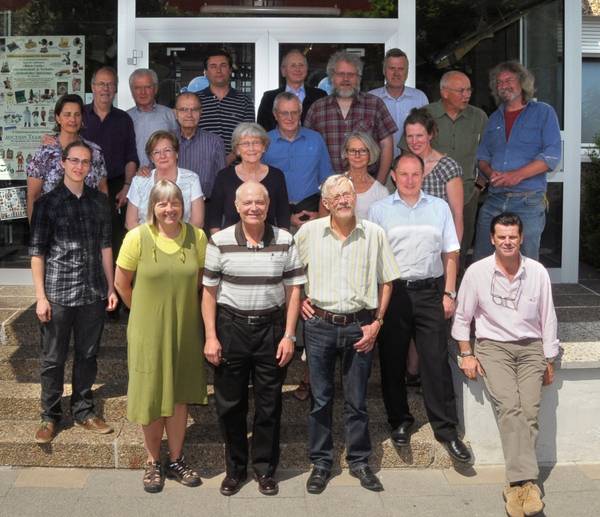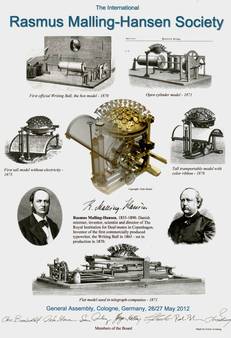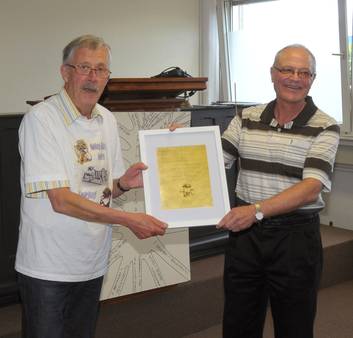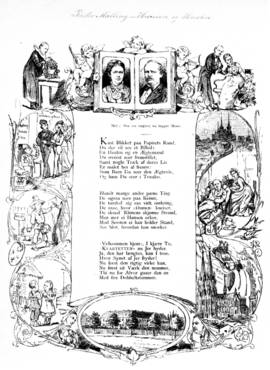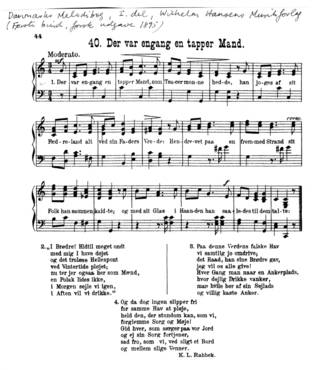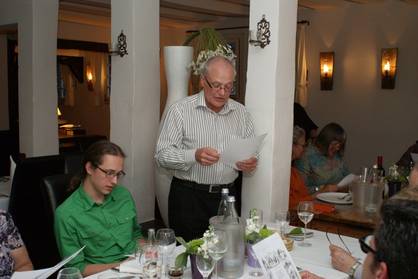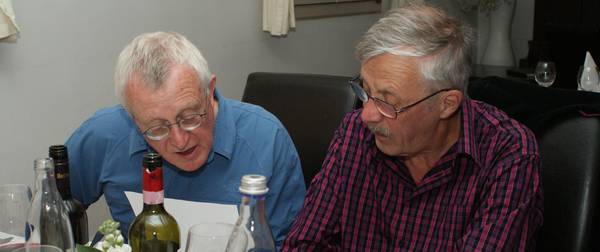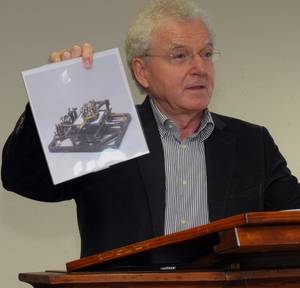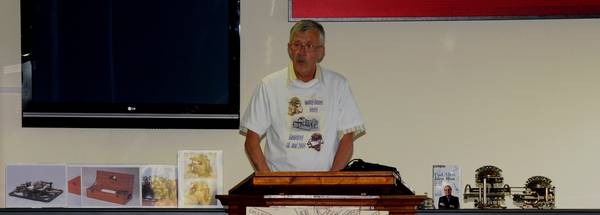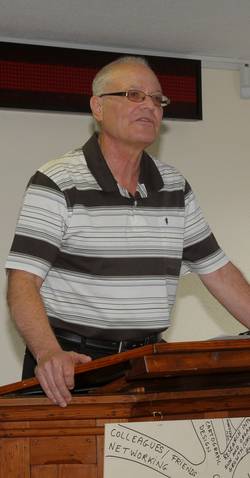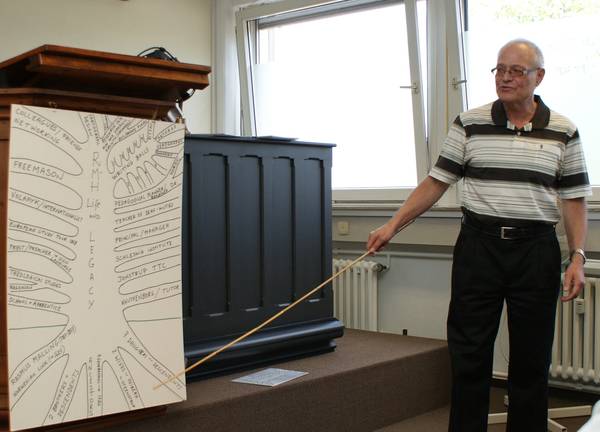Report from the 4th bi-annual General Assembly of The International Rasmus Malling-Hansen Society:
By Christian Barnholdt, ex-president
The International Rasmus Malling-Hansen Society held its fourth general assembly in Køln, Germany, om Sunday the 27th of May 2012 – with Celebration Dinner in the evening of Saturday the 26th.
The General Assembly was held on the invitation of Uwe Breker, board member of the Society and owner of the world’s largest auction house for technical antiques: Auction Team Breker.
The event took place in the building of this auction house, which was a fantastic frame for the event, full of thousands of beautiful technical antiques, ranging from typewriters, over mechanical toys and music machines to telephones, sewing machines and printing machines – including a copy of Gutenberg’s printing machine – the first in the world!!. See more on: www.auction-team.de
The General Assemby was held in the same week-end as the half-yearly auction of Auction Team Breker, gathering dozens of collectors from the whole world, and with a fantastic auction catalogue with over 800 numbers – which were all sold on the auction on Saturday the 26th.
The General Assembly.
Almost 30 members and friends of the Society participated in the general assembly, and more than 20 of them joined the celebration dinner, which took place at hotel Falkenhof on Saturday evening.
There were participants from 7 countries: Denmark, Germany, Netherlands, Austria, Switzerland, Spain and Italy.
5 of the 7 members of the board participated:
Jørgen Malling Christensen, Lars Mathiesen, Uwe Breker, Dieter Eberwein and Christian Barnholdt. Unfortunately our vicepresident and web-master Sverre Avnskog was ill and could not come. Paul Bech, from USA, was also prevented from joining.
In connection with the general assembly we were also invited to Uwe Breker’s welcome reception on Friday the 25th, where members of the Society met with typewriter collectors and Writing Ball fans from the whole world.
Uwe Breker had also arranged a fantastic Rasmus Malling-Hansen Exhibition, where he exhibited his own Malling-Hansen collection – including Malling-Hansen’s writing desk – and where one could see no less than 7 different specimens of the writing ball – brought to the exhibition by the participants of the general assembly. Many other Malling-Hansen items where in the exhibition, which attracted enormous interest – not only from the Society members but also from the participants in the Saturday auction. Our website provides a 360 degree panorama view of the exhibition hall!
This panorama picture of the convention room in Uwe Breker's localities was made by our very talented member, Felix Herbst from Germany. He has also made interactive visualizations of both the writing ball and the takygraf, which were presented at the genereal assembly. Notice the number of original writing balls shown at the exhibition.
Honeymoon song by Malling-Hansen's daughters
During the celebration dinner on Saturday, Jørgen Malling Christensen introduced a song which had been written to Malling-Hansen and his second wife, Anna, when they returned from their honeymoon travel in October 1880. The song had been written by four of Malling-Hansen’s daughters ranging from 9 to 14 years of age. By an almost incredible coincidence, their honeymoon travel went to Køln!!!! The occasion was the inauguration of the Kölner Dom, which was finished in 1880 – after 600 years of construction. The song can be seen on the website. The theme of the song is Malling-Hansen’s life, from he was a small boy – where he already as a child met Anna, who was later to become his second wife – to his post as principal of the Royal Institute of the Deaf.
Greetings to the convention
The General Assembly started at 9.30 on Sunday and the first speaker was the host Uwe Breker. He had sent out the invitation to the General Assembly to a large number of his world-wide contacts, including all known owners of Writing Balls, including most of the worlds technical museums.
A number of these persons and museums had sent their greetings to the General Assembly:
1. The Director of the Austrian Technical Museum in Vienna, Dr. Helmut Lackner, sends his greetings to the RMH Society and regrets that - by Austrian Law - it is not allowed to take any historical exhibit out of the country.
2) The President of the Deutsches Museum Munich, Prof. Dr. Wolfgang Heckl, writes: "Dear Mr President, members and friends of the 'International Rasmus Malling-Hansen Society'. With great pleasure, I learned about your Convention and the great work the Society did in the past few years."
3) Hans Barbian, Düsseldorf, long term member of the IFHB, regrets not to be able to join the Convention. He wishes a successful meeting and hopes to hear or read soon about the new results.
4) Norbert Schwarz, Board member of the IFHB, wrote: Ladies and gentlemen of the Malling-Hansen-Convention! As a board member for the contacts to the outside I was given the honourable task to summon you in the name of the IFHB a warm welcome. I sincerely thank our honorary member Uwe Breker, who has brought this important meeting to be in Cologne.
Your results are for the IFHB certainly of great interest and we would be grateful if you could share them with us. I wish your meeting on behalf of the IFHB a nice course of your conversation!
5. Prof. Dr. Gerhard Kilger from the DASA-Museum in Dortmund, feels very sorry not to bring their Malling-Hansen writing ball to the meeting as it is still on exhibit at the Friedrich Nietzsche Museum in Sils-Maria, in Switzerland.
6. And, last but not least: Paul Allen, the Co-Founder of Microsoft sends his regards to the Convention together with his new book which he signed and a photo of his 'Writing Ball', serial no. 159!
Report from the President
After Uwe Brekers welcome speech, the President of the Society Christian Barnholdt (CB) presented the Report of the Management Board. In this report CB underlined the enormous amount of time that particularly Dieter Eberwein, Jørgen Malling Christensen and Sverre Avnskog have spent, researching for all kinds of new information about RMH and the Writing Ball, and presenting this knowledge on the Society’s web-site. The website has grown into a large scale, high quality information bank about RMH, with hundreds of pages of text, documents and photos, and we have received many mails from particularly museum people from all over the world, praising the quality and contents of the web-site. Unfortunately our hard-working web-master in Norway, Sverre Avnskog was absent due to illness, but he received a warm applause from the General Assembly for his work with www.malling-hansen.org
The second point of the Presidents report dealt with the fact that Jørgen Malling Christensen (JMC) is building up a large scale archive/library in his home in Denmark, and has taken over a large number of RMH-documents that CB has collected during the past 25 years. JMC is thus the Societys official ’archivist and research manager’. JMC has done a fantastic job researching into the life and activities of RMH, and received a warm applause from the audience for his efforts.
The next point on the agenda was the financial report for the past two financial years, presented by the Auditor, Lars Mathiesen, who gave a short presentation with this information:
The Society has assets of 9250 kr. per May 26th 2012 and 22 paying members. It was decided that the annual membership fee will continue to be 40€.
Approval of the Management Board.
CB remarked that it was a little unclear how these words are to be understood, but the fact is, that the Management Board was approved by the participants and that all 7 members of the board were re-elected, since no other candidates had been suggested. This was met with applause from the participants.
Presentation and approval by voting of the suggested new formal rules of the Society.
Jørgen Malling Christensen presented the new rules, which he and Lars Mathiesen had worked out together, since the existing rules are not suited for an organisation as small as the Society.
The new rules were approved unanimously, with one change, suggested by JMC: §8 point 3 – mentioning the election of an auditor - was deleted from the new rules.
After this, the General Assembly was officially finished, but, as the former rules stated, the Board now chose two vice-presidents and a president from the 7 re-elected members. Sverre Avnskog and Dieter Eberwein were re-elected as vice-presidents, and
Jørgen Malling Christensen was elected as the new President, succeeding Christian Barnholdt, who wanted to ’retire’ after six years as President.
Jørgen Malling Christensen was warmly welcomed by the participants, and Christian Barnholdt was presented with a ’Memorial Plaquette’ for his 6 years as President and co-founder and initiator to the Society. Christian Barnholdt was also given life-long honorary membership of the Society.
After this the formal General Assembly ended, but was succeeded with 4 fascinating lectures about RMHs life and inventions.
1. Jørgen Malling Christensen, Denmark: Present and future research issues related to RMH.
2. Dieter Eberwein, Germany: The patent history of the writing ball and tachygraf from 1870 and onwards
- why Malling-Hansen was a genius far ahead of his time.
3. Jos Legrand, The Netherlands: Rasmus Malling-Hansen and his network and connections in Great Britain and with Tietgen – director of The Great NorthernTelegraph Company and Danish Business Tycoon.
4. Felix Herbst, Germany: Computer reconstruction of the writing ball and tachygraf and how they worked: An interactive visualization with ’hands on’.
After Felix Herbst’s presentation it was decided that all young persons up to and including the age of 25, can be accepted as members of the Society without membership fee.
Report worked out by Christian Barnholdt, June 13th 2012
Greetings to the convention
1) The Director of the Austrian 'Technical Museum in Vienna', Dr. Helmut Lackner, sends his greetings to the RM-H Society and regrets that - by Austrian Law - it is not allowed to take any historical exhibit out of the country..... But he sends instead some excellent photos of both the original Malling Hansen typewriters they have in their collection:
First of all: The electrical one from 1875, made by Albert von Szabel, Vienna, serial no. 22.
Secondly, the extremely rare wooden box "Writing Ball" of 1867 with exciting serial no. 10 and some detailed views.
Dr. Helmut Lackner wishes an interesting and successful convention in Köln.
2) The President of the „Deutsches Museum, Munich", Prof. Dr. Wolfgang Heckl, writes:
"Dear Mr President, members and friends of the 'International Rasmus Malling Hansen Society'.
With great pleasure, I learned about your Convention and the great work the Society did in the past few years.
During the past 20 years, typewriters disappeared in the offices worldwide. So it's even more important now to research the entire history of typewriting and to publish the new findings and results which the Malling Hansen Society did before in an exemplary manner on their website.
Since 1915, the "Deutsches Museum, Munich" owns an original Writing Ball by Malling Hansen, which is as a tremendous exhibition piece on exhibition since then and it is of course an outstanding beacon in our extensive typewriter collection.
As the Malling-Hansen Writing Ball is on permanent exhibit in our Museum, I regret that we can't transport the machine to your Convention in Cologne but I send you enclosed two photos for your presentation.
I wish your meeting a well course and hope to hear from your results very soon.
Best regards,
Prof. Dr. Wolfgang Heckl"
3) Hans Barbian, Düsseldorf, longterm member of the IFHB, regrets not to be able to join the Convention ... as he is on a business trip to Spain.
But he brought us both his original machines:
The 'Writing Ball' with Dr. 'Moon's blind keyboard, serial no. 105.
And the latest model of the 'Writing Ball' made in 1888 by Lyngbye, Copenhagen, with the platen carriage. This might be the only example which is still in existence worldwide.
He wishes a successful meeting and hopes to hear or read soon about the new results.
4) Norbert Schwarz, Board member of the IFHB, wrote:
"Ladies and gentlemen of the Malling-Hansen-Convention!
As a board member for the contacts to the outside I was given the honorable task to summon you in the name of the IFHB a warm welcome.
I sincerely thank our honorary member Uwe Breker, who has brought this important meeting to be in Cologne.
Your results are for the IFHB certainly of great interest and we would be grateful if you could share them with us.
I wish your meeting on behalf of the IFHB a nice course of your conversation!"
5) Prof. Dr. Gerhard Kilger from the DASA-Museum in Dortmund, feels very sorry not to bring their Malling-Hansen writing ball to the meeting as it is still on exhibit at the Friedrich Nietzsche Museum in Sils-Maria, in Switzerland.
6) And, last but not least: Paul Allen, the Co-Founder of Microsoft sends his regards to the Convention together with his new book which he signed and a photo of his 'Writing Ball', serial no. 159!
7) Some other owners of Malling-Hansen writing balls and artefacts unfortunately didn’t reply to the invitation, e.g. The Emir of Qatar, the Museums in Stockholm, Helsingor (DK), London, Paris, Bern (CH), the Smithsonian in Washington (USA) and Prague, as well as one of the editors of French ‚Le Figaro‘ ......
Rasmus Malling-Hansen: The Multiple Facets of His Life and Achievements
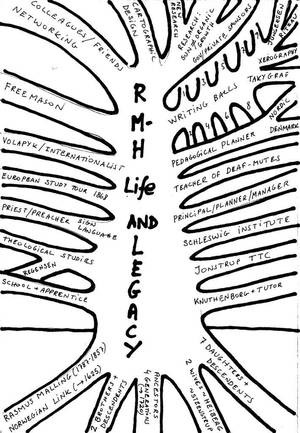
- The presentation was structured around the adjacent illustration of a large tree, where the roots represent RMH’s family – ancestors and descendents – as well as his foster father, Rasmus Malling, from whom he got the name Malling. The branches indicate major achievements as well as important phases of his life.
By Jørgen Malling Christensen
Summary of a presentation to the General Assembly of the International Rasmus Malling-Hansen Society May 27, 2012 in Cologne.
The presentation was structured around the adjacent illustration of a large tree, where the roots represent RMH’s family – ancestors and descendents – as well as his foster father, Rasmus Malling, from whom he got the name Malling. The branches indicate major achievements as well as important phases of his life.
The intention of the presentation was twofold:
a) to illustrate that his achievements were very diverse and broad, with important contributions and legacies in many different areas;
b) to point out areas where our society needs to do more research.
Starting with the root at 4 o’clock and moving around the picture clockwise, the following points are important to note:
1. 7 daughters and their descendents: We have a fairly complete register of all descendents of the 7 daughters, with numerous relatives and families living in Denmark and the USA, several of whom are members of the Society. However, we have only sketchy information of the lives of the daughters and their families (the most complete information at hand is about Johanne). We would like to find additional information and photos and include them on the website.
2. 2 wives: Both wives – Cathrine Georgia Heiberg (1841-1876) and Anna Steenstrup (1842-1897) – are from interesting and important families, and it is relevant to research these respective families in more detail and to include the findings on the website.
3. Ancestors: Luckily, RMH’s paternal ancestry has been researched thoroughly, and we have names and dates of all of his relatives back to 1720, i.e. his great-great-grandfather. On his mother’s side, however, the trail is cold, and we know little apart from the names of Juliane’s father Lars Matzen and mother Margrethe Jensine Pedersdatter.It would be interesting to find out why she was abandoned by Lars and Margrethe at such an early age and adopted by Rasmus Malling and his wife Ane Marie.
4. 2 brothers and their descendents: RMHs two younger brothers were Thomas Jørgen Hansen (1837-1919) and Johan Frederik Hansen (1839 – 1918). As far as we know Thomas had no children? However, Johan Frederik had one surviving daughter, Juliane Marie Hansen (1879-1958) from whom there were 9 children and a large number of descendents, some of whom are members of our Society.
5. Rasmus Malling: RMH’s foster father (1787-1857) was of huge importance to him, his brothers and to their mother. He hailed from an important and interesting Norwegian family, and we have traced his ancestry back to 1625. Our research in this respect seems fairly complete, but we still need to find out more about Rasmus Malling’s links to certain families of the Norwegian and Danish nobility.
6. RMH’s primary school studies (1842-1849), his contact with reverend Gude (1850), and his apprenticeship as a house painter(1850-1852): We are yet to find records of his schooling and of his 2 years as apprentice to be a house painter in Maribo.
7. Theological studies and his period at “Regensen”: There is as yet very scarce information about this period; in particular we need to find documentation about his residence at the university college of Regensen (1861-1862)
8. Priest and preacher in sign language: RMH is said to have been an remarkably skilled and talented preacher in sign languages. We need to find texts of his sermons and to learn more about his theological beliefs and priorities.
9. European study tour in 1868: As a young teacher of the deaf-mutes RMH was sent on a tour to some European countries in order to study how the teaching of various categories of deaf-mutes was organized. We have not yet found any report or documentation about this trip.
10. The international language Volapyk: RMH was one of the two most important Danish pioneers for the promotion of this artificial international language. We need to find more documentation about his achievements in this area (e.g.study the Danish Volapyk journal) and about his contacts with the other great promoter in this field, Wilhelm Hansen.
11. Freemason: As a very high-ranking member of a Masonic lodge, appointed as speaker for the lodge, there must be Masonic records of RMH’s contributions and achievements. Research in this area is very much called for.
12. Colleagues and friends: We know of some 40-50 important colleagues and friends of RMH, and in many cases there is scope for more research, trying to find correspondence or other documentation.
13. Cartographic design: We have found 6 world maps projected by RMH as part of his research into biological growth and solar (or cosmic) rays, but we are yet to learn how to interpret and understand these maps.
14. Research into solar (cosmic) rays and biological growth: There are at least five research avenues to follow up – a) document RMH’s private and public sponsorships; b) find out how RMH’s research influenced European, particularly German, medical research in his lifetime; c) Document how his research influenced Swedish scientists in the 19th century and in the 1930s (Gustav Nylin and others); d)find links with present day research into the influence of cosmic rays on circadian rhytms (Svensmark in Denmark e.g.); e) find RMH-documents taken over by the Antropological Committee, Denmark, in the 1920’s.
15. Writing balls, the takygraf and xerography: This is a vast research area, where we have done a lot already but much remains, e.g.:a) A number of writing ball patents are still missing; b) we still have not found the takygraf; c) need to update the list of known writing ball; d) we must include documentation on our website about the museums worldwide which own and exhibit writing balls; e) need to search newspapers and magazines from the 19th century to find additional articles about writing balls, the takygraf and the invention of xerography; f) include much more documentation on our website regarding the RMH keyboard and its superior qualities (ref Dieter Eberwein’s lecture May 2012); g) more research into RMH’s links with the Ritzau Agency ; h) Find out more about Jürgensen’s and Lyngbye’s companies; i) Continue the ongoing effort to check to what extent RMH and the writing ball are mentioned in Wikipedias of 60 different languages and add to the information provided plus ensure there are links to our Society website.
16. RMH as pedagogical reformer and planner in Denmark and in the Nordic countries: Much is already and has been documented by us, but we must continue to search documents related to RMH’s vast and deep influence as a reformer and planner of special education.
17. Teacher of deaf-mutes: We know that RMH was a brilliant and caring teacher, loved and respected, and we need more personal accounts of this aspect of his achievements.
18. Principal of the institute for the deaf-mutes, planner and daily manager: 25 years in this capacity and, again, we need more documentation and personal accounts by pupils, colleagues and friends about this area.
19. Schleswig Institute: Recently we have found and documented hitherto unknown material about his period at the institute (1862-64), and this line of research is to be followed up and deepened.
20. Jonstrup Teacher Training Institute: RMH was the key organizer of Jonstrup’s centenary jubilee and its keynote speaker. We must find documentation about his period as a student there1852-54.
21. Knuthenborg and his work as a tutor/assistant teacher: The Knuth family and the Knuthenborg manor were of decisive importance to his life and career; more research into local achives could reveal more about this period. Very little is known about his work as a tutor 1854-55.

